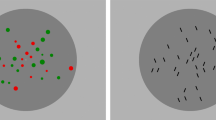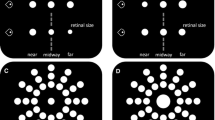Summary
Reaction time (RT) of normal subjects to square-wave gratings of two different frequencies were related to locus of presentation, area, and stimulus complexity. Each frequency was presented to either side of the horizontal meridian (half size stimulus) or both sides simultaneously (full size stimulus). The two different frequencies were also flashed simultaneously to both hemifields (compound stimulus). Stimulus position affected RT with the 1 c/deg stimulus, RT being faster for the lower hemifield. With presentation on both sides of the horizontal meridian simultaneously or of the two spatial frequencies, the resulting RT was equal to that of the faster component. Implications of the results for the functional organization of the visual system are discussed.
Zusammenfassung
Reaktionszeiten gesunder Versuchspersonen nach optischer Kontraststreifenreizung mit zwei verschiedenen Ortsfrequenzen (1 und 3 Perioden/Grad) wurden nach Ort, Größe und Komplexheit des Reizes verglichen. Jede der Ortsfrequenzen wurde entweder nur im oberen oder unteren Gesichtsfeld dargeboten oder aber in beiden Halbfeldern gleichzeitig. Außerdem wurden beide Reize gemeinsam in beiden Halbfeldern appliziert. Die Reaktionszeit wurde durch den Reizort bei einer Ortsfrequenz von einer Periode/° Reiz beeinflußt, mit kürzeren Reaktionszeiten im unteren Halbfeld. Bei gleichzeitiger Reizung im oberen und unteren Gesichtsfeld mit derselben oder verschiedenen Ortsfrequenzen entsprach die Reaktionszeit derjenigen der schnelleren Komponente. Ausdehnung und Komplexität hatten nur geringen Einfluß.
Die Bedeutung der Ergebnisse für die funktionelle Organisation des Sehsystems, für Asymmetrien der Gesichtsfelder bei Teilfeldreizen und für pathologische Veränderungen wird diskutiert.
Similar content being viewed by others
References
Berlucchi, G., Heron, W., Hyman, R., Rizzolatti, G., Umiltà, C.: Simple reaction times of ipsilateral and contralateral hand to lateralized visual stimuli. Brain94, 419–430 (1971)
Berstein, I. H., Rose, R., Ashe, V. M.: Energy integration in intersensory facilitation. J. Exp. Psychol.86, 196–203 (1976)
Breitmeyer, B. G.: Simple reaction time as a measure of the temporal response properties of transient and sustained channels. Vision Res.15, 1411–1412 (1975)
Campbell, F. W.: The transmission of spatial information through the visual system. In: The neurosciences, O. Schmitt, F. G. Worden (eds.), Third Study Program, pp. 95–103. Cambridge: MIT Press 1974
Campbell, F. W., Maffei, L.: Electrophysiological evidence for the existence of orientation and size detectors in the human visual system. J. Physiol. (Lond.)207, 635–652 (1970)
Campbell, F. W., Maffei, L., Piccolino, M.: The contrast sensitivity of the cat. J. Physiol. (Lond.)229, 719–731 (1973)
Donchin, E., Lindsley, D. B.: Average evoked potentials and reaction times to visual stimuli. Electroencephalogr. Clin. Neurophysiol.20, 217–223 (1966)
Eason, R. G., Oden, B. A., White, C. T.: Visually evoked cortical potentials and reaction time in relation to the site of retinal stimulation. Electroencephalogr. Clin. Neurophysiol.22, 313–324 (1967)
Eason, R. G., White, C. T., Bartlett, N.: Effects of checkerboard pattern stimulation on evoked cortical responses in relation to check size and visual field. Psychon. Sci.2, 113–115 (1970)
Fiorentini, A., Maffei, L.: Contrast in night vision. Vision Res.13, 73–80 (1973)
Julesz, B., Breitmeyer, B., Kropfl, W.: Binocular-disparity dependent upper-lower hemifield anisotrophy and left-right hemifield isotropy as revealed by dynamic random-dot stereograms. Perception5, 129–141 (1976)
Kulikowski, J. J., Tolhurst, D. J.: Psychophysical evidence for sustained and transient detectors in human vision. J. Physiol.232, 149–162 (1973)
Lindquist, E. F.: Design and analysis of experiments in psychology and education. Boston: Houghton Mifflin 1953
Lupp, U., Hauske, F., Wolf, W.: Perceptual latencies to sinusoidal gratings. Vision Res.16, 969–972 (1976)
Maddess, R. J.: Reaction time to hemiretinal stimulation. Neuropsychologia13, 213–218 (1975)
MacKay, D. M., Jeffreys, D. A.: Visually evoked potentials and visual perception in man. In: Handbook of sensory physiology, R. Jung (ed.), Vol. VII/3, Part B, pp. 647–678. Berlin Heidelberg-New York: Springer 1973
Maffei, L., Campbell, F. W.: Neurophysiological localization of vertical and horizontal visual coordinates in man. Science167, 386–387 (1970)
Maffei, L., Fiorentini, A.: Retinogeniculate convergence and analysis of contrast. J. Neurophysiol.35, 65–72 (1972)
Maffei, L., Fiorentini, A.: The visual cortex as a spatial frequency analyzer. Vision Res.13, 1255–1267 (1973)
Mansfield, R. J. W.: Latency functions in human vision. Vision Res.13, 2219–2234 (1973)
Mecacci, L., Spinelli, D.: The effects of spatial frequency adaptation on human evoked potentials. Vision Res.16, 477–479 (1976)
Michael, W. F., Halliday, A. M.: Differences between the occipital distribution of upper and lower field pattern-evoked responses in man. Brain Res.32 (1971)
Nachmias, J.: Effect of exposure duration on visual contrast sensitivity with square-wave gratings. J. Opt. Soc. Am.57, 421–427 (1967)
Payne, W. H.: Reaction time as a function of retinal location. Vision Res.6, 729–732 (1966)
Payne, W. H.: Visual reaction times on a circle about the fovea. Science155, 481–482 (1967)
Rains, J. D.: Signal luminance and position effects in human reaction time. Vision Res.3, 239–251 (1963)
Tartaglione, A., Goff, D. P., Benton, A. L.: Reaction time to square-wave gratings as a function of spatial frequency, complexity and contrast. Brain Res.100, 111–120 (1975)
Teichner, W. H.: Recent studies of simple reaction time. Psychol. Bull.51, 128–149 (1954)
Teichner, W. H., Krebs, M. J.: Laws of the simple visual reaction time. Psychol. Rev.79, 344–358 (1972)
Tolhurst, D. J.: Separate channels for the analysis of the shape and the movement of a moving visual stimulus. J. Physiol.231, 385–402 (1973)
Tolhurst, D. J.: Reaction time in the detection of gratings by human observers: A probabilistic mechanism. Vision Res.15, 1143–1149 (1975)
Vassilev, A., Mitov, D.: Perception time and spatial frequency. Vision Res.16, 89–92 (1976)
White, C. T.: The visual evoked response and patterned stimuli. Adv. Psychobiol.2, 274–278 (1974)
Author information
Authors and Affiliations
Rights and permissions
About this article
Cite this article
Tartaglione, A., Favale, E. & Benton, A. Visual reaction time as a function of locus, area, and complexity of stimulus. Arch. Psychiat. Nervenkr. 227, 59–69 (1979). https://doi.org/10.1007/BF00585678
Received:
Issue Date:
DOI: https://doi.org/10.1007/BF00585678




